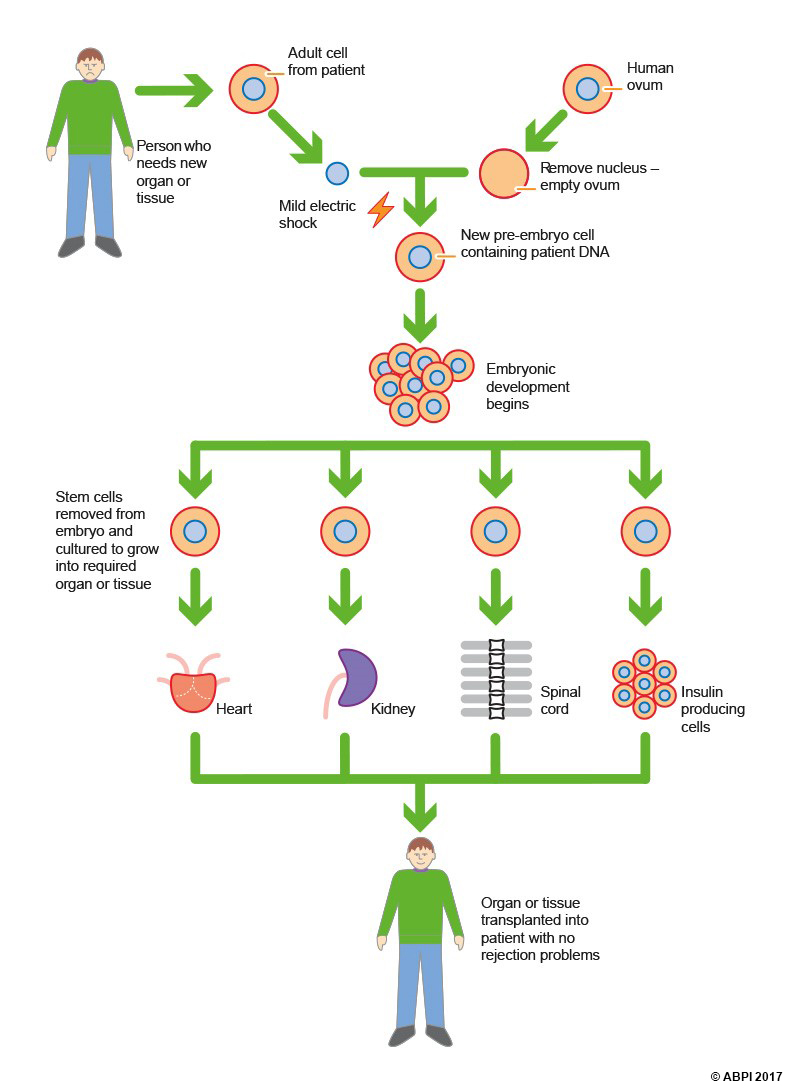This topic takes on average 55 minutes to read.
There are a number of interactive features in this resource:
 Biology
Biology
 PSHE / Citizenship studies
PSHE / Citizenship studies
The techniques used in therapeutic, or biomedical, cloning are very similar to those used in reproductive cloning – but with a completely different outcome. The nucleus of an egg cell is removed and replaced with the nucleus of a somatic cell, meaning the egg has the same amount of genetic material as if it were fertilised. An artificial stimulus is supplied to the egg which prompts it to divide in the same way as an embryo. The early embryo produced, however, isn’t allowed to develop: instead stem cells are harvested from it (thereby destroying the embryo) so it cannot develop into a cloned adult.

The principles of therapeutic cloning
This method is strictly controlled to ensure that it never results in the birth of a clone. Human cells can be cloned using this method as long as the researcher holds licences from the Human Fertilisation and Embryology Authority and the Human Tissue Authority. Cloning human cells in this way is made more problematic by a shortage of donated human eggs. To make sure that valuable research isn’t prevented by this, hybrid therapeutic clones can be legally produced from a human nucleus and a donor egg from another species. These contain human nuclear genetic material (which is most of the genetic material in the cell) and a very small amount of genetic material from the donor species in the mitochondria in the cytoplasm. The cytoplasm effectively acts as an ‘incubator’ for the nucleus: it doesn’t direct how the embryo develops, but it does need to provide the right conditions. Unless the nucleus and donor egg are from very similar species, they are mostly incompatible (because the cytoplasm doesn’t provide the correct conditions for the nucleus) and this prevents the embryo developing past an early stage.
Stem cells are very useful for two reasons, both of them due to the fact that the cells are a clone of the nuclear donor. The stem cells produced can be cultured and grown into a tissue (or possibly an organ in the future) which can then be transplanted back into the patient to replace a damaged area of the body. As the cells are clones of the patient, there can be no immune rejection because of genetic incompatibility. If the stem cells produced are clones of someone with a genetic disorder, the development of the disease can be studied in further detail and possible treatments tested at a cellular level in the laboratory. It is even possible that the faulty genes could be silenced or replaced and the cells returned to the patient.
Stem cells produced from cloned embryos may become redundant if induced pluripotent stem cells (iPSCs) fulfil their potential, but for the moment they are still an incredibly important and exciting line of research.
Therapeutic cloning is strictly controlled to ensure that it never results in the birth of a clone.
What are some of the ethical issues surrounding cloning?
For some more information look at the link below:
The ethical considerations, Scientific American
